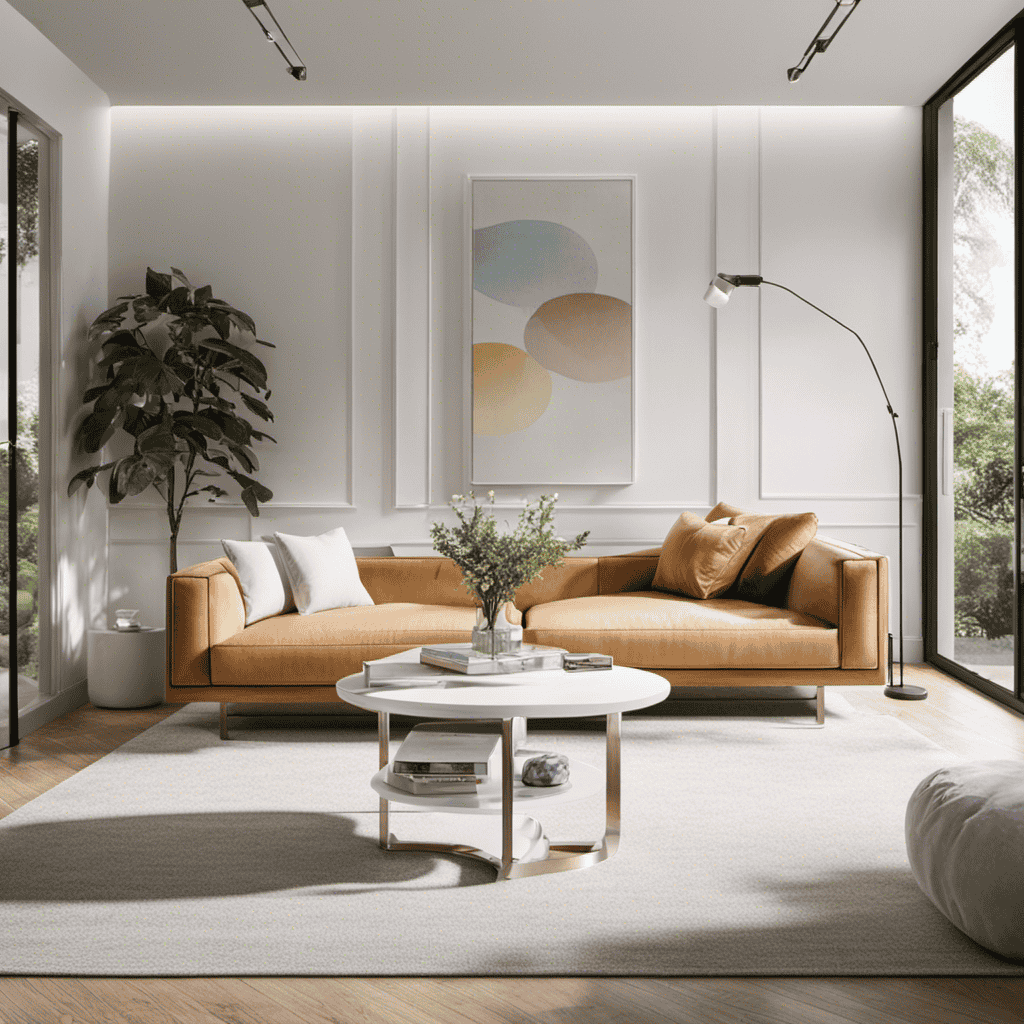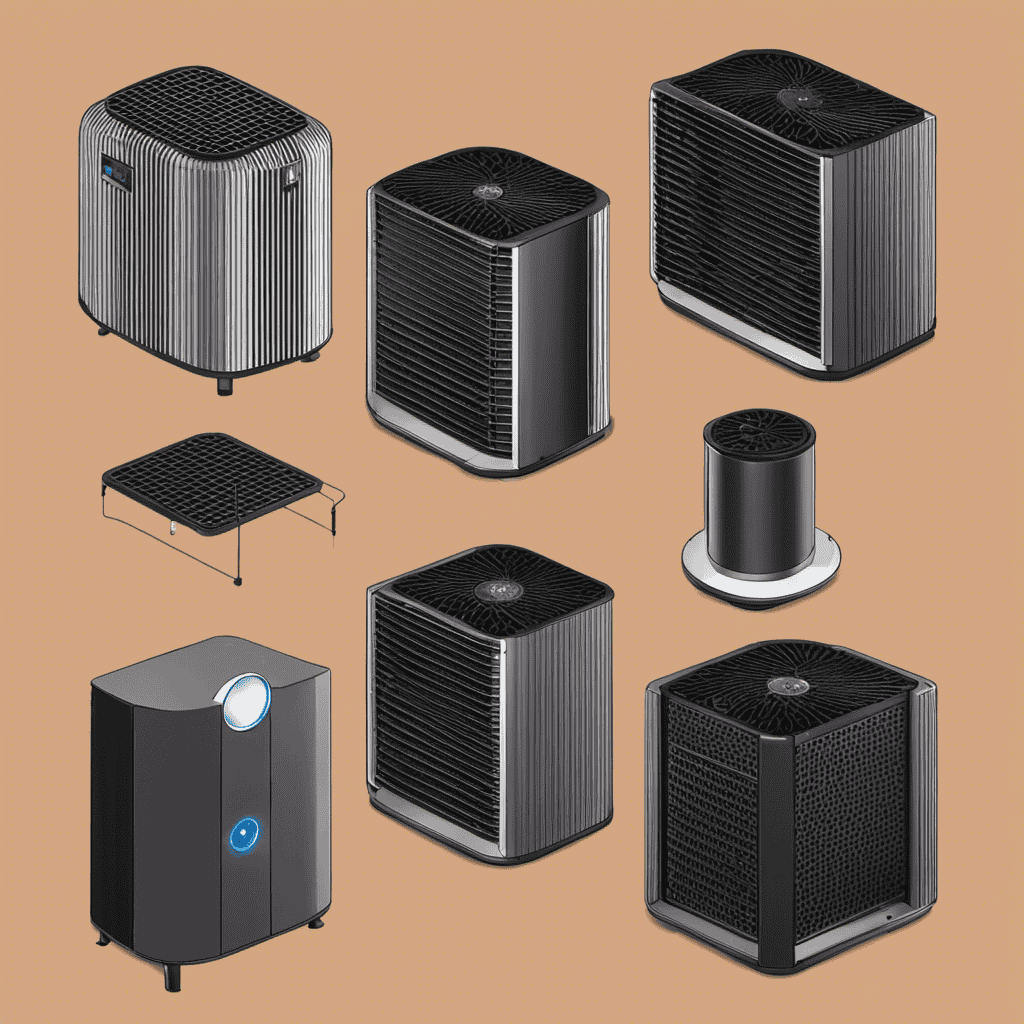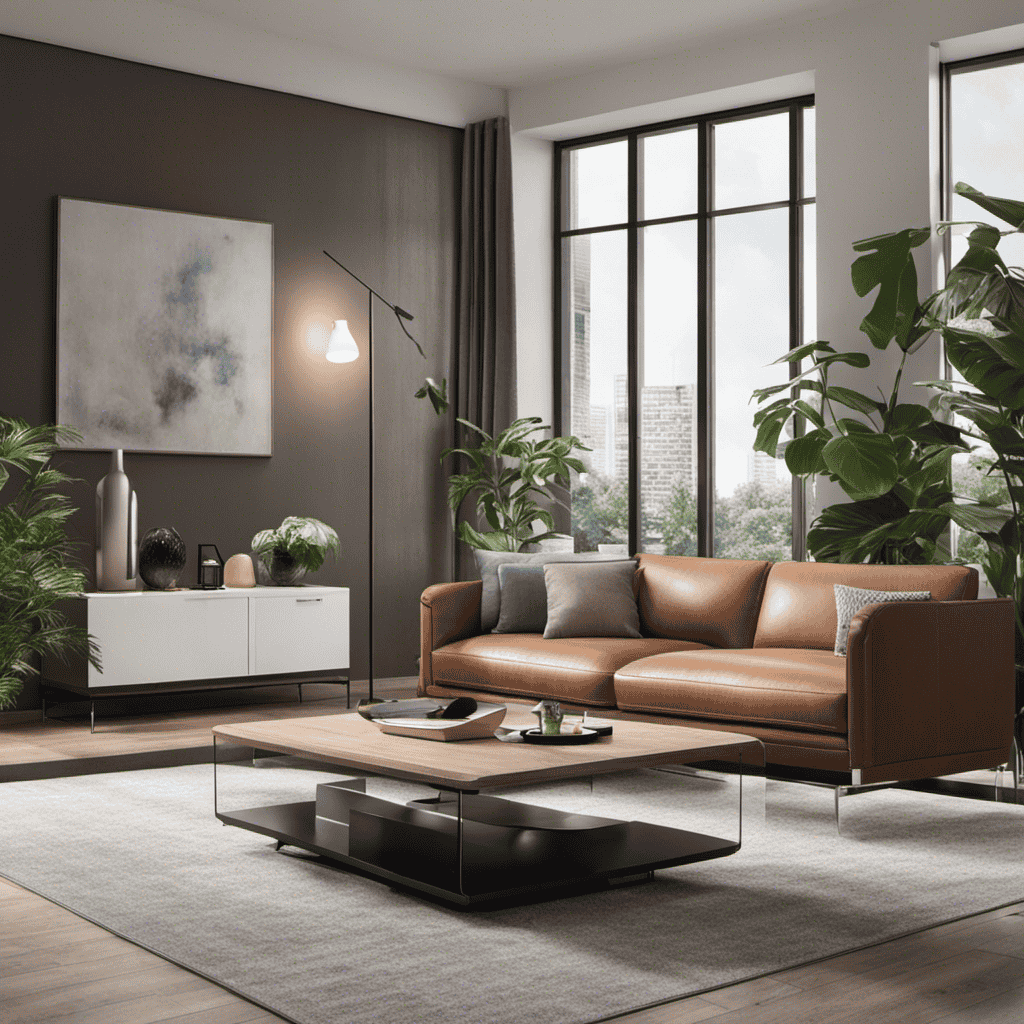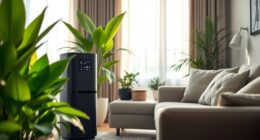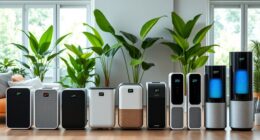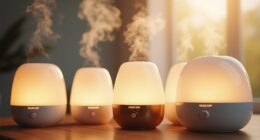As someone who cares about having clean and healthy air, I have frequently asked myself how to select the best air purifier for my home. With a plethora of choices on the market, it can be daunting to make a choice. Nonetheless, with the proper information, discovering the ideal air purifier becomes significantly simpler.
In this article, I will guide you through the process of buying an air purifier, helping you understand your needs, compare different types, and consider important factors such as filtration systems and maintenance costs.
Let’s embark on this journey together to breathe in pure, fresh air.
Key Takeaways
- Assess the size of the area you want to purify
- Consider the specific features you require
- Determine if you need activated carbon filters for odor removal
- Evaluate if you need HEPA filters for trapping allergens
Determine Your Air Purifier Needs
First, you need to figure out what your specific air purifier needs are. When choosing the right air purifier, it’s important to consider several factors.
Start by assessing the size of the area you want to purify. Air purifiers come in different sizes and have varying coverage capacities, so you want to ensure that the one you choose can effectively clean the air in your space.
Additionally, consider the specific features you require. Some common air purifier features include activated carbon filters for odor removal, HEPA filters for trapping allergens, and UV-C lights for germ-killing. Understanding your specific needs will help you narrow down the options and choose an air purifier that meets your requirements.
Now, let’s move on to the next section and understand the different types of air purifiers.
Understand the Different Types of Air Purifiers
When you’re looking for an air purifier, it’s important to know the different types available. Understanding the various types will help you make an informed decision based on your specific needs.
One important factor to consider is filtration effectiveness. Different air purifiers use different filtration methods, such as HEPA filters, activated carbon filters, or UV light. HEPA filters are highly effective at removing particles as small as 0.3 microns, while activated carbon filters are great at removing odors and chemicals.
Another consideration is noise reduction techniques. Some air purifiers are designed to operate quietly, making them ideal for bedrooms or offices where silence is important. Look for air purifiers with features like noise-reducing fans or sound-absorbing materials to ensure a peaceful environment.
Consider the Size and Coverage Area
One important factor to consider is the size of the room and the coverage area you need when buying an air purifier. The size of the room will determine the capacity of the air purifier you should choose. It is essential to select a purifier that can effectively clean the air in the given space. To help you determine the right size requirements, consider the following table:
| Room Size | Coverage Area |
|---|---|
| Small (up to 300 sq. ft.) | 200-300 sq. ft. |
| Medium (up to 500 sq. ft.) | 300-500 sq. ft. |
| Large (up to 1000 sq. ft.) | 500-1000 sq. ft. |
Research the Filtration System
When it comes to researching the filtration system of an air purifier, it is important to compare different filter types to determine which one is the most effective.
Through this comparison, one can evaluate factors such as the filter’s ability to remove particles and pollutants from the air, its lifespan, and its maintenance requirements.
Filter Types Comparison
There’s a significant difference between HEPA, activated carbon, and ionizer filters.
When it comes to effectiveness, HEPA filters are considered the gold standard for air purifiers. They are capable of capturing 99.97% of particles as small as 0.3 microns.
Activated carbon filters, on the other hand, excel at removing odors, gases, and chemicals from the air. They work by adsorbing these substances onto their porous surface.
Ionizer filters, also known as electrostatic precipitators, use an electrical charge to attract and trap airborne particles. While they are effective at removing particles from the air, they can produce ozone as a byproduct, which can be harmful in high concentrations.
In terms of cost analysis, HEPA filters are generally more expensive than activated carbon and ionizer filters, both in terms of initial purchase and replacement costs. However, considering their superior effectiveness, they are worth the investment for those with specific air quality concerns.
Effectiveness of Filtration
HEPA filters capture particles as small as 0.3 microns, making them highly effective at improving indoor air quality. When considering the effectiveness of air purifiers, filtration efficiency is a crucial factor to evaluate. A higher filtration efficiency means that more airborne particles are trapped and removed from the air. To demonstrate the importance of filtration efficiency, let’s compare two air purifiers: one with a filtration efficiency of 95% and another with a filtration efficiency of 99%.
| Air Purifier | Filtration Efficiency |
|---|---|
| Purifier A | 95% |
| Purifier B | 99% |
As shown in the table, Purifier B has a higher filtration efficiency, meaning it can capture a greater number of particles. This indicates that Purifier B is more effective at removing pollutants from the air, resulting in cleaner indoor air quality. When choosing an air purifier, considering its filtration efficiency is essential to ensure the best results.
Evaluate the CADR (Clean Air Delivery Rate
To accurately assess an air purifier’s effectiveness, evaluate its CADR (Clean Air Delivery Rate). The CADR is a measure of how efficiently an air purifier can remove pollutants from the air. It is calculated by testing the purifier’s ability to remove three common pollutants: smoke, dust, and pollen. A higher CADR indicates a faster and more thorough purification process.
When evaluating an air purifier’s CADR, it is also important to consider its noise levels and energy efficiency. Noise levels can significantly impact comfort, especially if the purifier will be used in a bedroom or office. Comparing energy efficiency can help determine the long-term cost of operating the air purifier.
Assess Noise Levels
When it comes to assessing noise levels in air purifiers, there are a few key points to consider.
First, noise level recommendations can help determine the appropriate level of noise for different environments.
Second, understanding the benefits of silent operation can be crucial, especially in settings where noise can be disruptive or distracting.
Lastly, implementing noise reduction techniques can further enhance the overall experience of using an air purifier, making it more enjoyable and user-friendly.
Noise Level Recommendations
Consider choosing an air purifier with a noise level below 50 decibels for a quieter and more peaceful environment. When comparing noise levels of different air purifiers, it is important to consider the benefits of quiet operation.
A quieter air purifier can provide a more comfortable living space, especially during nighttime when we need a restful sleep. Excessive noise can cause disturbances and disrupt our sleep patterns, leading to fatigue and decreased productivity.
Additionally, a quiet air purifier is less likely to cause annoyance or distraction, allowing us to focus on our work or leisure activities without any interruptions. Scientific studies have shown that exposure to constant loud noise can have negative effects on our physical and mental health, such as increased stress levels and impaired cognitive function.
Therefore, investing in an air purifier with a noise level below 50 decibels is a wise choice for a peaceful and healthy indoor environment.
Silent Operation Benefits
A quieter air purifier with silent operation provides a more peaceful and relaxing environment for improved well-being. When it comes to air purifiers, noise reduction techniques play a crucial role in enhancing the user experience. Here are three benefits of silent operation:
-
Whisper-quiet: Imagine sitting in a room with the gentle hum of a quiet air purifier in the background, barely noticeable. It creates a serene ambiance, allowing you to focus, relax, or sleep undisturbed.
-
Uninterrupted sleep: With a silent air purifier, you can enjoy a restful night’s sleep without any disruptive noise. The absence of loud whirring or buzzing ensures that you wake up refreshed and rejuvenated.
-
Enhanced concentration: Whether you’re studying or working, a silent air purifier helps eliminate distractions and improves concentration levels. The calm environment promotes productivity and efficiency.
Noise Reduction Techniques
Using advanced technology, manufacturers have successfully developed air purifiers with noise reduction techniques, resulting in a quieter and more peaceful environment.
Noise reduction techniques in air purifiers are crucial for improving the overall user experience and promoting better sleep quality.
One common technique employed is the use of noise-absorbing materials in the construction of the purifier, which helps to dampen and reduce noise levels.
Additionally, manufacturers have also incorporated advanced fan designs and soundproofing technologies to minimize operational noise.
The benefits of quiet operation in air purifiers are numerous. Not only does it prevent disturbances and distractions, but it also allows users to enjoy a more peaceful and relaxing atmosphere in their homes or offices.
This is particularly beneficial for individuals who are sensitive to noise or those who require a quiet environment for work or rest.
Compare Energy Efficiency Ratings
When you’re shopping for an air purifier, don’t forget to check out the energy efficiency ratings. Energy efficiency is an important factor to consider when making a cost effectiveness comparison. Here are three key aspects to look for:
-
Energy Star certification: Look for air purifiers with the Energy Star label, as they meet strict energy efficiency guidelines set by the Environmental Protection Agency. This ensures that the unit operates efficiently and consumes less energy, saving you money on electricity bills.
-
Adjustable fan speeds: Opt for air purifiers that offer multiple fan speed settings. This allows you to customize the airflow and energy consumption based on your needs. Running the unit on lower fan speeds can help reduce energy usage without compromising air purification effectiveness.
-
Timer function: Some air purifiers come with a timer function that allows you to set specific operating hours. This feature can help you save energy by automatically turning off the unit when you don’t need it, such as when you’re away or sleeping.
Considering the energy efficiency ratings of an air purifier is essential to make an informed decision and maximize cost effectiveness.
Now that we’ve covered this aspect, let’s look into additional features and technology.
Look Into Additional Features and Technology
Now that you know about energy efficiency ratings, let’s explore some additional features and technology to consider. When purchasing an air purifier, it’s important to look beyond just its energy efficiency. There are many additional features and technologies available that can enhance its performance and convenience. One such feature is the use of smart technology in air purifiers. Smart air purifiers are equipped with sensors and connectivity options that allow you to control and monitor the device remotely using your smartphone or voice commands. They can also provide real-time air quality data and automatically adjust their settings to maintain optimal indoor air quality. Additionally, some air purifiers come with advanced filtration systems, such as HEPA filters or activated carbon filters, which can effectively remove a wide range of pollutants from the air. Investing in an air purifier with these additional features and technologies can greatly improve the air quality in your home and provide you with a more convenient and efficient experience.
| Additional Features and Technology |
|---|
| Smart Technology |
| Advanced Filtration Systems |
| Remote Control |
| Real-time Air Quality Monitoring |
| Voice Control |
Check for Certifications and Safety Standards
When it comes to choosing an air purifier, it’s important to consider certifications and safety standards. Certified air purifiers have undergone rigorous testing to ensure their effectiveness in removing pollutants from the air.
Additionally, safety standards provide assurance that the purifier meets certain requirements for electrical safety and emissions.
Certified Air Purifiers
Certified air purifiers are highly recommended for those with allergies or respiratory issues. When shopping for an air purifier, it is crucial to consider the safety standards and certifications it holds. Here are three key reasons why certified air purifiers are a smart choice:
-
HEPA Filter: Certified air purifiers typically come equipped with high-efficiency particulate air (HEPA) filters. These filters are proven to remove 99.97% of airborne particles, including allergens, dust, and pet dander. Breathing cleaner air can significantly improve respiratory health.
-
VOC Removal: Volatile organic compounds (VOCs) are harmful gases emitted by household products and building materials. Certified air purifiers often have activated carbon filters that effectively trap and eliminate these chemicals, ensuring cleaner and safer indoor air quality.
-
Ozone-Free Operation: Some air purifiers emit ozone, a harmful gas that can irritate the lungs and worsen respiratory conditions. Certified air purifiers adhere to strict safety standards, ensuring they operate without producing any ozone, keeping the air in your home safe and healthy.
Safety Standards for Purifiers?
To ensure the safety of your indoor air, it’s important to consider the specific safety standards that air purifiers adhere to.
One crucial aspect to look for is the HEPA filter requirements. HEPA stands for High Efficiency Particulate Air, and these filters are designed to remove 99.97% of particles as small as 0.3 microns from the air. When choosing an air purifier, make sure it meets the HEPA filter requirements to effectively remove pollutants such as dust, pollen, and pet dander from your indoor environment.
Additionally, it’s essential to consider the testing protocols that air purifiers undergo. Look for certifications like the AHAM Verified mark, which ensures that the purifier has been independently tested and meets specific performance standards.
Read Customer Reviews and Ratings
Check out what other customers are saying about the air purifier you’re interested in before making a decision. Customer satisfaction is an important factor when it comes to purchasing an air purifier. User feedback can provide valuable insights into the performance and reliability of a product.
Here are three things to consider when reading customer reviews and ratings:
-
Effectiveness: Look for reviews that mention how well the air purifier works in removing pollutants and improving air quality. Positive feedback about noticeable improvements in allergies or asthma symptoms is a good indicator of its effectiveness.
-
Noise level: Pay attention to reviews that mention the noise level of the air purifier. A quiet operation is important, especially if you plan to use it in the bedroom or office.
-
Durability: Look for reviews that discuss the durability and longevity of the air purifier. It’s important to invest in a product that will last and continue to perform well over time.
Set a Budget
When it comes to buying an air purifier, there are several key factors to consider.
One of the most important considerations is the balance between price and performance. It’s crucial to find a unit that offers both effective purification and a reasonable price point.
Additionally, affordability and quality are crucial aspects to evaluate to ensure that you are getting a product that is durable and reliable.
Lastly, value for money is essential as you want to make sure that the air purifier you choose provides the best possible performance for the price you pay.
Price Vs. Performance
The price doesn’t always reflect the performance of an air purifier. When it comes to buying an air purifier, it’s important to consider the price analysis along with the performance evaluation. Here are three key factors to consider:
-
Filter efficiency: Look for air purifiers with high-efficiency particulate air (HEPA) filters. These filters are capable of capturing particles as small as 0.3 microns, ensuring cleaner air for you and your family.
-
Clean air delivery rate (CADR): This metric measures the amount of clean air an air purifier can deliver in a specific amount of time. Higher CADR values indicate better performance and faster air purification.
-
Noise level: Consider the noise level of the air purifier, especially if you plan to use it in a bedroom or office. Look for models with low noise ratings to ensure a peaceful and undisturbed environment.
Affordability and Quality
Affordability and quality are important factors to consider when choosing an air purifier for your home or office. It’s crucial to find a balance between the two to ensure you’re getting the best value for your money. When it comes to affordability options, there are several factors to consider. One important aspect is the initial cost of the air purifier. Additionally, you should also consider the cost of replacement filters and the energy consumption of the device. On the other hand, brand reputation plays a significant role in determining the quality and reliability of an air purifier. It’s essential to research and choose a brand with a good reputation for producing effective and long-lasting air purifiers. By considering both affordability options and brand reputation, you can ensure you make a wise and informed decision when purchasing an air purifier.
| Affordability Options | Brand Reputation |
|---|---|
| Initial cost | Product reviews |
| Replacement filters | Customer ratings |
| Energy consumption | Brand history |
| Warranty |
Value for Money
In terms of value for money, noise level recommendations play a crucial role when buying an air purifier. It’s important to find a balance between affordability and quality in order to make a wise investment.
When considering noise level recommendations, there are a few key factors to keep in mind:
- Whisper-quiet operation: Look for air purifiers that operate at low decibel levels, ensuring minimal disturbance while you sleep or work.
- Adjustable fan speeds: Having the option to customize the fan speed allows you to control the noise level based on your preferences and needs.
- Noise reduction technology: Some air purifiers are equipped with advanced features that reduce noise, such as sound-dampening materials or improved airflow design.
Consider Maintenance and Filter Replacement Costs
When considering an air purifier, it’s important to factor in the costs of maintenance and filter replacements. Regular maintenance is crucial to ensure optimal performance and extend the lifespan of your air purifier. Here are some maintenance tips to keep in mind:
-
Clean or replace filters: Filters trap airborne particles and pollutants, but they can become clogged and less effective over time. Check the manufacturer’s recommendations for filter cleaning or replacement intervals.
-
Vacuum the unit: Dust and debris can accumulate on the surface and vents of the air purifier. Regularly vacuuming the exterior helps maintain its efficiency.
-
Keep the air purifier clean: Dust and pet hair can accumulate inside the unit, affecting its performance. Clean the interior periodically following the manufacturer’s instructions.
To better understand the costs associated with maintenance and filter replacements, refer to the table below:
| Maintenance Task | Frequency |
|---|---|
| Filter Replacement | Every 6-12 months |
| Cleaning the Unit | Every 2-3 months |
| Vacuuming the Exterior | Monthly |
Considering these costs and maintenance requirements will help you make an informed decision when purchasing an air purifier. Now, let’s move on to the next important aspect to consider: checking the warranty and customer support.
Check Warranty and Customer Support
Checking the warranty and customer support is essential when considering the purchase of an air purifier. The warranty coverage and customer satisfaction can greatly impact the overall value and experience of owning an air purifier. Here are three important factors to consider:
-
Length of Warranty: A longer warranty period indicates that the manufacturer has confidence in their product’s durability and performance. It also provides peace of mind for potential issues that may arise.
-
Coverage Terms: Understanding what the warranty covers is crucial. Some warranties may only cover specific components, while others may include comprehensive coverage for repairs and replacements.
-
Customer Support: Good customer support ensures that you can easily reach out to the manufacturer for assistance or troubleshooting. Responsive and helpful customer service can greatly enhance your overall experience with the air purifier.
Considering these factors will help you make an informed decision and ensure that you are satisfied with your air purifier purchase.
Research Reputable Brands and Manufacturers
To ensure you are purchasing a reliable product, it’s important to research reputable brands and manufacturers. By focusing on reputable brands and manufacturers, you can have confidence in the quality and performance of the product you choose.
Start by reading customer reviews and testimonials from people who have already purchased from these brands or manufacturers. Look for certifications and safety standards that the product meets, such as HEPA filters or CADR ratings. Reputable brands and manufacturers will often have these certifications prominently displayed on their packaging or websites.
Compare Prices and Make a Final Decision
After reviewing customer reviews and certifications, it’s time to compare prices and make a final decision on which reputable brand or manufacturer to choose for your air purifier. When comparing prices, there are a few key factors to consider:
-
Features: Look for air purifiers that offer a wide range of features such as HEPA filters, activated carbon filters, and UV-C light technology. These features can greatly improve the effectiveness of the air purifier in removing pollutants from the air.
-
Room Size: Consider the size of the room you plan to use the air purifier in. Some models are designed for smaller spaces while others are suitable for larger rooms. It’s important to choose an air purifier that is capable of adequately purifying the air in your specific room size.
-
Maintenance Costs: Take into account the ongoing costs of maintaining the air purifier. This includes the cost of replacing filters and other consumables. Some models may have higher maintenance costs than others, so it’s important to factor this into your decision-making process.
Frequently Asked Questions
Are Air Purifiers Effective in Removing All Types of Pollutants?
Yes, air purifiers are effective in removing all types of pollutants. They improve indoor air quality by eliminating dust, allergens, pet dander, smoke, and other harmful particles. The benefits of air purifiers include reducing allergies and respiratory issues.
How Often Do Air Purifier Filters Need to Be Replaced?
Air purifier filters need to be replaced regularly to maintain optimal performance. Signs of a dirty air filter include reduced airflow and increased dust accumulation. Proper air purifier maintenance ensures clean air quality.
Can Air Purifiers Help With Allergies?
Air purifiers can be helpful for allergies, including asthma and pet dander. Research suggests they can reduce airborne allergens and improve indoor air quality, but it’s important to choose the right one for your needs.
Are There Any Potential Health Risks Associated With Using Air Purifiers?
There may be potential side effects associated with using air purifiers, but the long-term effects are still uncertain. It is important to consider factors such as filter quality and maintenance when purchasing an air purifier.
Do Air Purifiers Consume a Lot of Electricity?
Do air purifiers consume a lot of electricity? Air purifiers vary in energy efficiency, so it’s important to choose one that meets your needs. Look for models with energy-saving features to minimize electricity consumption.
Can You Recommend Air Purifiers That Insurance Companies Typically Cover?
Yes, many insurance companies cover air purifiers for specific health conditions. To find out how to get insurance cover for air purifiers, you will need to check with your insurance provider and inquire about the specific requirements and documentation needed for coverage.
Conclusion
In conclusion, after thoroughly researching and considering various factors, I’ve decided to buy an air purifier. As the saying goes, "Prevention is better than cure." Investing in a good quality air purifier is a step towards preventing respiratory issues caused by indoor air pollution.
By understanding my needs, considering different types, researching filtration systems, and comparing prices, I’m confident that I’ve made an evidence-based decision. This decision will help improve the air quality in my home and safeguard my health.
